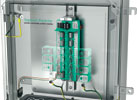

When it comes to automating processes, fieldbus systems provide a high level of reliability. However, thunderstorms mean that these installations are regularly subjected to the risk of voltage peaks. Lightning protection modules are used to prevent electronics from being damaged when storms occur. A new generation of surge protectors is now available equipped with a self-monitoring function. These surge protectors indicate when they need to be replaced, significantly improving the reliability of the infrastructure.
Surge protector components are put under enormous stress during a lightning strike. Although the modules are specifically designed for these kinds of voltage peaks, they can withstand only a certain number of these events before they ultimately fail. The timing of this failure hinges on two factors: the number of strikes and their intensity. For example, although the lightning protection device would need to be replaced immediately after a single violent pulse of 20 kiloamperes, the functional reserve would only be exhausted after around 1000 minor surges of three kiloamperes. What’s more, wear does not occur on a linear basis, but instead increases disproportionately with age – as does the risk of failure.
Innovative technology for maximum security
With this in mind, Pepperl+Fuchs has developed an innovative lightning protection device equipped with an automatic self-monitoring function that reports when its functional reserve is exhausted. To achieve this function, the FieldConnex surge protector measures the number and intensity of each surge and uses this data to accurately calculate when the available lightning protection has been used up. However, the performance of the lightning protection device can also decline over time in the day-to-day operation of a plant as a result of multiple small power surges. This type of wear may have different technical implications:
• One-sided ground faults that occur due to leakage from the suppressor diode or gas discharge tube connected to the positive or negative side.
• Signal attenuation due to the increased resistance of the suppressor diode or gas discharge tube.
• Increase in no-load current due to leakage from the suppressor diode or gas discharge tube connected to the positive or negative side.
• Attenuation of the signal amplitude as a result of increased series resistance.
• Changes in the signal quality (jitter) based on altered impedance caused by a worn suppressor diode or gas discharge tube.
The effects mentioned above bring about a qualitative change in the physical layer. The FieldConnex diagnostics infrastructure detects this change at an early stage and reports it before faults can occur.
If the lightning protection device is worn out, the FieldConnex surge protector gives a warning that it needs to be replaced. The diagnostics software also sends a message to the control room with details of the affected location. At a click of the mouse, the diagnostics manager creates a report that documents the condition of all connected surge protectors. If the functional reserves of modules have been depleted, the affected modules can be replaced in a timely manner on a targeted basis. By taking this approach, time-consuming and cost-intensive manual checks after thunderstorms are a thing of the past. The FieldConnex surge protector uses the physical layer to report all of this information to the control room. In this way, information is transmitted alongside process communication, without interfering with this communication or making great demands on bandwidth.
High potential for savings in operation

A case study shows how efficient it is to use a FieldConnex surge protector from Pepperl+Fuchs. The study was based on a small process plant with a hundred fieldbus segments, with eight field devices per segment and a total of 1800 lightning protection modules fitted. The number of lightning strikes that a plant such as this is exposed to each year depends on its geographic location. A typical standard value is five to 10 strikes per kilometre per year. The study worked on the basis of up to three strikes – a realistic, albeit conservative, assumption.
Standards stipulate that surge protectors must be checked at least once a year, or after every strike. In the case of the FieldConnex surge protector equipped with self-monitoring function, all that is required to perform these checks is access to the diagnostic manager software to test the devices. The process for calling up the data from the individual modules is simple, taking no longer than five minutes. Any faulty devices that must be replaced can then be identified from the report generated.
Lightning protection modules equipped with a self-monitoring function are admittedly more expensive than those without such a diagnostic function, ie, conventional modules would require a manual test on each of the 1800 devices after every strike. Thus, the higher costs of purchasing lightning protection devices equipped with a diagnostic function are paid off as early as the second year of ownership, where a plant experiences three strikes a year, by removing the need for time-consuming and expensive manual checks.
Simply plug-in – no further engineering required
The innovative surge protectors are quick and easy to both install and replace, with no problems. The lightning protection module can simply be plugged into the device coupler, ie, the segment protector or FieldBarrier. There is no need for an intermediate level of wiring, a fact that saves both time and money. Even the commissioning process is easy, as the advanced diagnostics system detects the modules independently. What’s more, existing plants with older series of device couplers can be retrofitted with surge protectors without further engineering measures.
As with all intelligent FieldConnex diagnostic technology components, the surge protector is compatible with Foundation fieldbus H1 and Profibus PA bus systems. The lightning protection module is available for all common types of explosion protection, such as intrinsic safety and increased safety.
For more information contact Mark Bracco, Pepperl+Fuchs, +27 (0)87 985 0797, [email protected], www.pepperl-fuchs.co.za
| Tel: | +27 10 430 0250 |
| Email: | [email protected] |
| www: | www.pepperl-fuchs.com/en-za |
| Articles: | More information and articles about Pepperl+Fuchs |

© Technews Publishing (Pty) Ltd | All Rights Reserved